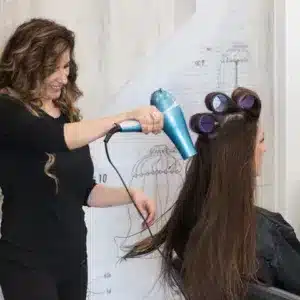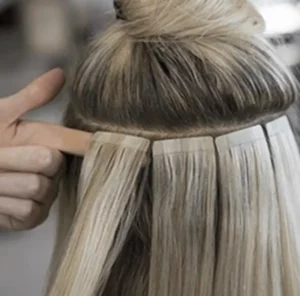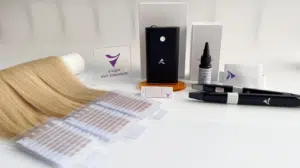Do weft extensions help or harm? Salons ask. Clients worry. Let’s cut the guesswork and look at types, wear-time, risks, and the right install and care.
Weft extensions are safe when the hair, method, tension, and maintenance are right. Choose the correct weft type, install on balanced anchors (braids or beads), keep weight proportional, and move up on time. Below I map types, longevity, pros, cons, and pro standards.

We manufacture wefts for professional use, so we focus on materials, construction, installation physics, and service cycles. Let’s go step by step and keep it practical for stylists, wholesalers, and salon owners.
What are the types of weft extensions ?
Not all wefts feel or behave the same. Construction changes thickness, flexibility, and shed control.
Common categories include machine weft, volume weft, hand-tied weft, genius weft, and flat/silk-sealed weft. Each offers a different balance of cut-ability, bulk, comfort, and invisibility.
Core categories and how they differ
As a factory, We group wefts by how the hair is assembled and how the top is sealed.
Regular Machine Weft: We stitch two passes of hair with an industrial wefting machine. The track is sturdier, a bit thicker, and very durable. Stylists can cut it to length with minimal shedding when the cut edge is sealed. It suits most hair types and classic sew-in or beaded-row installs. It is cost-effective for wholesale and high-volume work.

Volume Weft: We stack extra hair on the same track (often three layers). You get faster fullness with fewer rows. The band is thicker than hand-tied or genius. It is great for dense hair clients or dramatic volume builds. Cutting is allowed, with sealing.

Hand-Tied Weft: We stitch by hand. The track is ultra-thin and flexible. It sits very flat under fine or medium hair. It is not designed to be cut, because cutting breaks the hand knot and causes shedding. Stylists plan panel lengths before install and fold ends to fit.
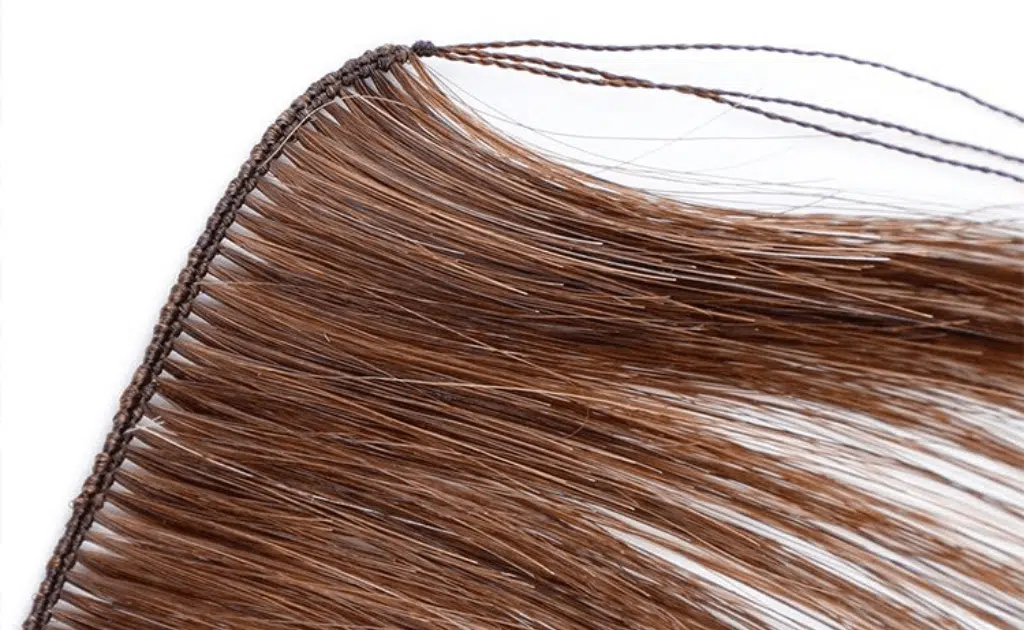
Genius Weft: We engineer a very thin, low-profile top like a hand-tied look, but it can be cut anywhere without shedding. There is no “mustache” return hair. It blends easily in beaded-row and hybrid methods and is now a luxury salon favorite for its versatility.

Flat/Silk-Sealed Weft: We seal the top with a thin, soft polymer or silk-like tape to reduce bulk and irritation. It lies flat like a hand-tied, allows cutting like machine weft, and resists fray. It is comfortable under sensitive scalps and works well in layered rows.

Quick comparison table
| Weft type | Cuttable | Track bulk | Best for | Notes |
|---|---|---|---|---|
| Machine | Yes (seal edge) | Medium | Most hair types, durable installs | Budget-friendly, sturdy |
| Volume | Yes (seal edge) | Medium-High | Fast fullness, dense hair | Fewer rows, more weight |
| Hand-tied | No | Ultra-low | Fine/medium hair, invisible rows | Plan lengths, fold ends |
| Genius | Yes | Low | Most hair types, luxury blends | No mustache, high versatility |
| Flat/Silk | Yes | Low | Sensitive scalps, sleek profiles | Soft top, comfy wear |
how long do weft extensions last
Service cycle vs. hair lifespan
We separate service cycle (time until move-up) from hair lifespan (how long the hair stays salon-grade).
- Service cycle (move-up): 6–10 weeks is the safe range for beaded-row or braided sew-ins, because natural hair growth drops the row. Waiting longer increases traction on grown-out anchors, creates loops and matting, and strains the weft stitching.
- Hair lifespan: With full cuticle, single-donor wefts, I see 9–12 months in normal conditions. Heavy heat, salt/chlorine, hard water, or rough brushing can halve that. Non-remy or silicone-heavy hair may only look fresh for 1–3 months.
Variables that change the numbers
- Hair origin and processing: Full cuticle hair (no acid bath, no heavy silicone) keeps strength, so it tolerates re-installs. Heavily processed, coated hair looks glossy at first but decays fast once the coating washes off.
- Row design: Two lighter rows often outlast one very heavy row. Even weight matters more than raw grams.
- Client habits: Night braids, extension brush, heat protectant, and sulfate-free wash extend life. Wet-brushing, tight ponytails, and daily 200°C irons shorten it.
- Water chemistry: Hard water minerals dull color and roughen cuticle; a filter and chelating detox reset softness and shine.
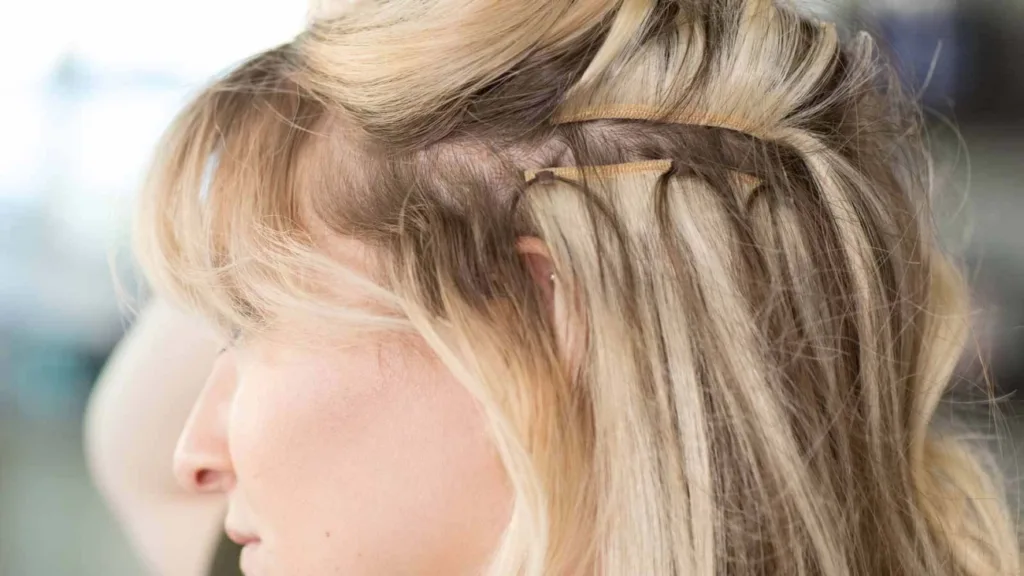
are weft extensions bad for your hair
Wefts harm hair only when weight, tension, and care go wrong. The method itself is not the enemy.
When a trained stylist sizes the row to the hair, sets safe tension, uses correct anchors, and schedules move-ups, wefts are safe. Problems come from over-weighted rows, poor sectioning, neglect, or late maintenance.
What “bad” actually means in a salon context
Stylists worry about traction alopecia and breakage. We audit installs by four pillars:
1) Anchoring: Whether you sew to small cornrow anchors or to beads for a braidless install, each anchor must carry predictable load. Beads should be lined with silicone and sized to the hair density. Braids must not be tiny or over-tight. Anchors must sit in healthy, non-fragile zones.
2) Tension and weight: A row that feels snug but not painful is right. Pain or headache after install signals excess tension. Weight must match density. Fine hair might need hand-tied or genius wefts in fewer grams. Coarse hair can carry machine or volume wefts safely.
3) Row architecture: Rows must mirror head shape. Overlapping too close to hairline or crown creates peek-through and strain. Leave “freedom zones” near part and nape. Blend lengths, and stack thinner panels rather than one heavy band.
4) Maintenance: Clients must keep a 6–8 week move-up cadence, dry roots after washing, brush from tips to roots with an extension brush, and sleep in a loose braid. Skipping these steps leads to matting, anchor slip, and stress on follicles.
When things go wrong
- Signs of overload: Redness, tenderness, or itching under beads or braids; hair shedding concentrated at anchor points; row “smiling” away from scalp; consistent headaches; broken short bits along the anchor line. Any of these mean remove or lighten the row and re-anchor correctly.
Bottom line
With the right weft type, conservative grams, and clean install logic, wefts are not bad for your hair. They become risky only when we ignore fundamentals.
Pros and Cons of weft extensions
Every system trades something. Wefts offer speed, reuse, and blend; they ask for discipline and skill.
Pros that matter to salons
- Reusable investment: Premium wefts re-install many times, so cost per wear drops.
- Speed and scalability: A trained stylist can install rows quickly, which improves chair flow.
- Seamless blend: Thin-track options (hand-tied/genius/flat) vanish even in finer hair.
- Custom layout: Stylists stack weft types for coverage, color effects, or face-frame density.
- Low daily effort: Clients brush, braid at night, dry roots. No daily attachment work.
Cons to manage with education
- Maintenance cadence: 6–10 week move-ups are non-negotiable. Late visits lead to stress.
- Weight sensitivity: Fine or compromised hair cannot carry heavy grams or thick tracks.
- Water and lifestyle: Swimmers, heavy gym users, or hard-water areas need stricter care.
- Learning curve: Beaded-row or hybrid sewing requires good training and clean sectioning.
- Not ideal for severe thinning: Diffuse thinning or active scalp disorders are a red flag. Alternatives like toppers or tapes with wider distribution may be safer.
Practical pro/cons table
| Aspect | Pro | Con | Control measure |
|---|---|---|---|
| Cost per wear | Reusable hair | Upfront higher | Choose full-cuticle hair |
| Install time | Quick rows | Skill-dependent | Education + mapping |
| Comfort | Thin tracks | Can feel tight | Check tension test |
| Maintenance | Simple routine | Regular move-ups | Pre-book cycles |
| Suitability | Most densities | Very fragile hair | Reduce grams or switch method |

Installation methods for weft extensions?
Sew to braids or sew to beads; the goal is the same—spread weight safely and evenly.
Two pro standards exist: braided sew-in (cornrow anchor) and braidless beaded-row (micro-beads as anchors). Both can be safe when sectioning, bead size, and stitching are correct.
Braided sew-in (cornrow anchor)
- Anchors: Create flat, medium-size cornrows that match head shape. Avoid tiny, high-tension braids. Keep scalp hydrated and clean.
- Stitching: Sew wefts to the braid with curved needle and nylon/poly thread. Use lock stitches every 1–1.5 inches. Stack 1–3 wefts per row depending on density goals.
- Strengths: Very stable, great for dense or textured hair, minimal slippage.
- Watch-outs: Over-tight braids on fine hair increase risk. Dry the base fully after washing to prevent odor or itching.
Braidless beaded-row (beads as anchors)
- Anchors: Place silicone-lined micro-beads along a clean horizontal parting. Each bead holds a small, consistent slice of hair. Close beads gently; do not crush.
- Stitching: Lay the weft on the beads and sew through the weft and the bead track. Use lock stitches, keep tension even, and leave freedom zones at temples and crown.
- Strengths: Flatter base, comfortable for many clients, quicker removal and move-up. Great for genius/hand-tied blends.
- Watch-outs: Bead spacing must be consistent. Too few beads = too much load per anchor; too tight beads = breakage.
Care and maintenance for weft extensions?
Good care protects the anchors and the cuticle. Simple habits add months of life.
Daily and weekly habits
- Brushing: Use an extension brush. Start at ends, work up. Support the row with your hand.
- Washing: 2–3 times a week. Focus shampoo at scalp, let suds run through lengths. Rinse well. Condition mids and ends only. Squeeze water out—do not rough towel.
- Drying: Dry anchors fully with medium heat and low airflow. Damp bases weaken beads and thread.
- Styling: Use heat protectant. Keep irons under ~180°C/356°F when possible. Avoid daily max heat.
- Night care: Loose braid or silk scrunchie pony. Silk pillowcase reduces friction.
- Water chemistry: In hard-water areas, use a shower filter and a stylist-approved chelating wash every 2–4 weeks, followed by a deep conditioner.
Service cadence
- Move-ups: 6–8 weeks for most. Very fast growers may need 5–6 weeks. Never exceed 10 weeks.
- Row refresh: At move-up, detangle the base, remove shed hair caught at anchors, and reset rows.
Product rules
- Shampoo: Sulfate-free, extension-safe. Clarify only as needed.
- Conditioner/Mask: From mid-lengths down. Keep oils and butters away from anchors.
- Leave-ins: Lightweight serums on ends. Avoid alcohol-heavy products.

Who are weft extensions best for?
Ideal candidates
- Healthy scalp and stable shedding
- Normal to dense hair that can share weight across anchors
- Fine hair when using lighter, thin-track wefts (hand-tied/genius) and reduced grams
- Clients wanting reusable hair and fewer daily steps than individual bonds
Caution or alternatives
- Active scalp conditions (psoriasis flares, dermatitis, recent surgery): wait or choose a non-tension system.
- Severe diffuse thinning: the anchor slices are too weak. Consider toppers, tapes with wider distribution, or medical guidance.
- High-impact athletes or frequent swimmers: still possible, but plan lighter rows, strict drying, and mineral management.
Consultation checklist
Density mapping, lifestyle review, water quality, heat habits, color goals, and maintenance budget. When in doubt, start with fewer grams and add later.
My opinion
As a manufacturer that serves pro salons, I see safe results when stylists pick the right weft for the right head, install with even tension, and educate clients well. The question “are weft extensions bad for your hair?” misses the point. The method is a tool. Technique and maintenance decide the outcome.
FAQ
Q: Are weft extensions bad for your hair if I have fine hair?
A: Not by default. Use thin-track wefts (hand-tied/genius), reduce grams, widen anchor distribution, and keep a 6–8 week move-up. If fine hair is fragile from breakage or health issues, choose a lighter method.
Q: Which is safer—braided sew-in or beaded-row?
A: Both are safe in trained hands. Braided is very stable on dense or textured hair. Beaded-row is flatter and quick to adjust. The best choice depends on density, scalp sensitivity, and stylist skill.
Q: How many grams do I need for volume vs. length?
A: Volume-only often needs 60–100g. Length + volume often needs 120–180g. Very dense goals may exceed 200g, but only when anchors can carry it.
Q: How often do I move up weft extensions?
A: Every 6–8 weeks is ideal. Never pass 10 weeks, as grown-out rows strain follicles and stitching.
Q: Can I cut hand-tied wefts?
A: No. Cutting breaks hand knots and causes shedding. Plan panel lengths or fold the ends. Genius, machine, and flat/silk wefts can be cut when you seal edges if required.
Q: Do weft extensions cause headaches?
A: They should not. Headaches mean tension or excess weight. Remove, lighten, and re-anchor.
Q: Will hard water ruin my wefts?
A: Minerals dull color and roughen cuticle. Add a shower filter, use chelating shampoo monthly, and follow with a deep conditioner.
Q: What products should I avoid?
A: Avoid heavy oils and conditioners at the base. Avoid high-alcohol sprays. Always use heat protectant and keep anchors dry.
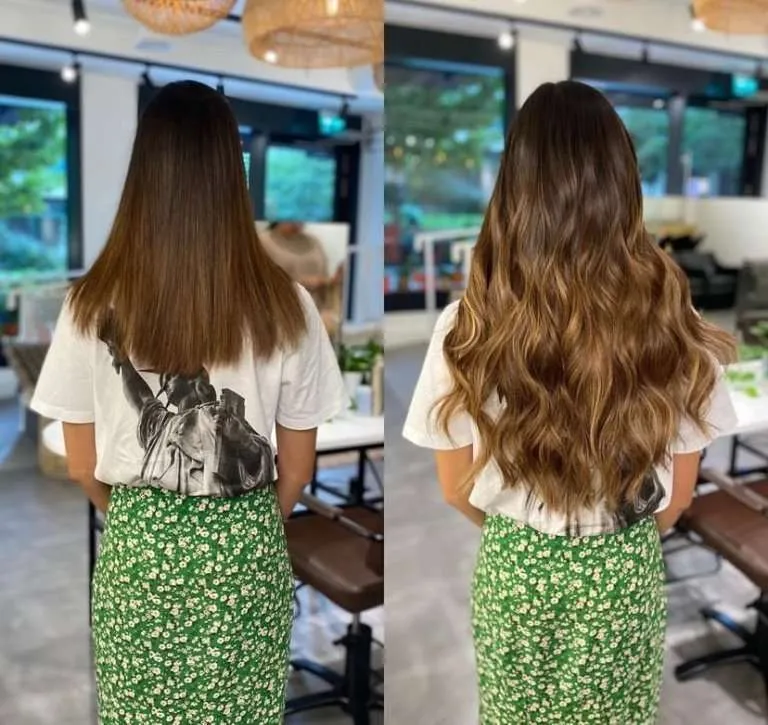
Conclusion
Weft extensions are not “bad”; poor match, excess weight, and late maintenance are. Choose the right weft, anchor well, move up on time, and care simply. Safe, seamless, repeatable.
Hibiscus Hair Manufacturer has been dedicated to producing high-quality weft hair extensions for 25 years and is a recognized leader in the industry. If you are interested in finding a reliable hair extensions supplier and wholesale for your brand, please visit our website for more information:
HAIR WEFT


